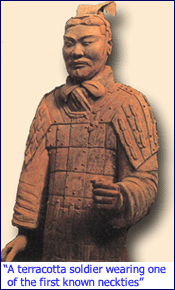|
|
 |


 |
 Shih
Huang Ti's, necktie wearing, terracotta soldiers: 221 B.C. Shih
Huang Ti's, necktie wearing, terracotta soldiers: 221 B.C.
It was a humid September morning in 1974 when a group of Chinese
peasants set out for a hillock in the fields near the ancient capital
city of Xi'an to dig a new well. They only had one thought in their
minds, to find a new source of clean water for their village, which
they could drink safely and use to irrigate their crops. They neither
wanted nor expected to find anything else under Mount Li, and when
one pick struck clean through a layer of stone and opened the way
into a hidden cavern, they merely hoped that they had discovered
an underground river.
In fact, they had stumbled on the tomb of China's first emperor,
Shih Huang Ti, containing the world famous "terracotta army"
arid evidence of the first known necktie. Under the rubble and mud
in the vault they had opened lay some 7,500 of the emperor's sculptured
soldiers, each wearing a carefully wrapped neck cloth.
Shih Huang Ti, alternatively known as Qin Shi Huangdi, was a warlord
who had succeeded in unifying China and founding the Qin dynasty
in 221 B.C. He was a fierce arid ambitious man who relished battle
and thought nothing of forcibly recruiting millions of his countrymen
to build the Great Wall and the network of roads, which allowed
his troops to move quickly around his empire. But he was afraid
of one thing, death. He did his best to find some way of avoiding
it, sending messengers to Tibet and India in search of a miraculous
elixir that would allow him to stay on his throne forever.
Finally, when he realized that he would inevitably die like other
men, he began to build a magnificent tomb near his capital city.
At first, he intended to slaughter an entire army, who would then
accompany him through eternity, but he was eventually persuaded
to make do with their life-sized replicas modeled in terracotta.
The greatest sculptors and artists from every province in China
were summoned to create this massive monument to one man's fear
and folly, and were set to work forming legions of archers, horsemen,
foot soldiers and officers. Each figure was unique, and every detail
of armor, hair and costume was reproduced meticulously. And when
Shih Huang Ti died in 210 B.C. during a routine round of inspection,
he was placed in this extraordinary mausoleum and forgotten.
What is remarkable about the discovery of the 7,500 soldiers wearing
their 7,500 neck cloths is that no other pictures or statues of
Chinese or, indeed, of any other people would show any evidence
of neck cloths for centuries to come.
Chinese looms of that period were certainly able to weave silk of
the right width for the neck cloths worn by the terracotta army.
Records show that in 16 B.C., during the reign of Ch'eng Ti, the
frontier garrison was given one million rolls of silk 32 feet 9
inches (10 m) long and 1 foot 8 inches (53 cm) wide. But only Shih
Huang Ti's personal guards seem to have wrapped material around
their necks. Why should they have done something so bizarre?
|
|
 |